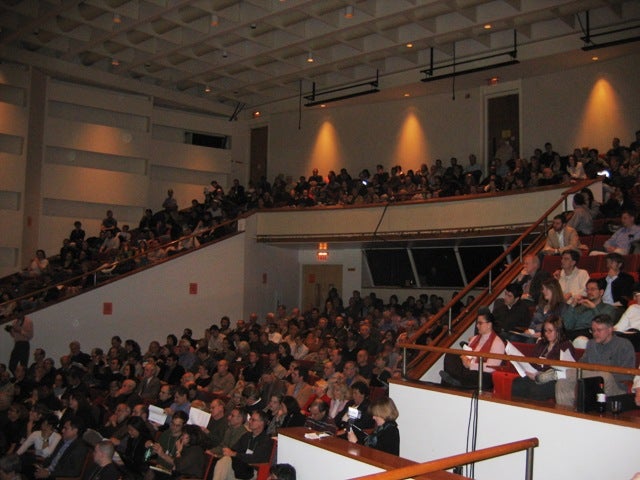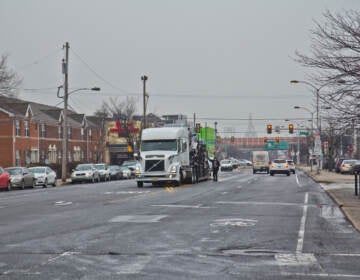Public reacts to design ideas

March 3
By Linda K. Harris
For Plan Philly
Exciting. Great. Interesting. Refreshing. Impressive. Wonderful.
Those were the words people were tossing about following the Saturday afternoon presentation of possibilities for the future of Philadelphia’s Central Delaware River waterfront.
It was the third day of Penn Praxis’ marathon process of visioning, brainstorming and creating, as design professionals, city planners and neighborhood activists joined forces at the Independence Seaport Museum to begin the imaginative first phase of reinventing the Delaware River waterfront, and by doing so, literally transforming the city of Philadelphia.
For months, Penn Praxis had cultivated the voices of neighborhood groups, enjoining them to establish a set of values and principles that would guide the riverfront’s rebirth.
At 3 p.m., the presentations of the five groups’ work began and by 5 p.m., Philadelphia had been cast as a paradigm of diverse uses for a postmodern urban environment. Enthusiasm erupted into applause for some of the ideas that surfaced.
Denise Scott Brown, the celebrated architect who led a group charged with studying the various connections of the city – historical, visual, physical, among others – told the standing-room-only crowd that she and her group had especially kept in mind one of the values the neighborhood groups had pushed to the top of their priority list: “Keep it real, Philadelphia.” The applause was thunderous.
But no idea was greeted more joyously than the proposal to put Interstate 95 underground.
The idea was put forth by Gary Hack, dean of the University of Pennsylvania’s School of Design, who then asked: “What do you gain? Well, what you gain is a city.”
The crowd roared as if David Akers had just kicked a 38-yard field goal to win the playoff game.
“I think it’s exciting,” said Kathleen McGrann of Pennsport. “I love the part about putting I-95 underground.” McGrann was also enamored of the suggested bike path: “I think it’s great.”
Laura Lane of Society Hill, who had participated in the earlier values and principles sessions, liked the inspiration of thinking big. “This is your moment and don’t do it halfway,” she said. “You need political will. That resonated for me. I’m not sure we have the political smarts. I’m not sure we have politicians who are able to pull it off.”
Robert M. Brasler, a developer and former president of the National Constitution Center, said he was impressed with the presentations.
“I thought it was well done. The boldness, the necessary boldness. … who has the character and drive to pull that off?”
Standing next to him, Mitchell Gordon, a writer from Washington Square West, quipped: “Can we get Gary Hack to run for mayor?”
Gordon also said he believed that Interstate 95’s existence surely needed to be updated.
“It’s no longer financially reasonable to have I-95,” where it is, he said. And once it no longer is taking up valuable real estate, “then everything falls into place.”
Sesame Worku of South Philadelphia
was also abuzz about Interstate 95. “The plan they came up with is refreshing. It opens up the space for other development.”
Martha Abraham of Upper Darby was impressed by the scope of the ideas and their humanity.
“I was impressed about the care for the people. It’s much bigger than what I had in mind.”
And Worku agreed. “It makes your brain expand.”
Former Philadelphia mayor Bill Green said “it’s a huge undertaking. It’s complicated. This political will is very important.”
Green said it would be helpful to address both banks of the river and include the Camden waterfront. “There are two sides of the river. We shouldn’t be concerned with just one side.”
Martha Cross of Washington West was impressed by the ideas of Walter Hood and his group who worked on the southern end of the seven-mile stretch of the Penn Praxis study area, from Washington Avenue to Oregon Avenue.
Hood, professor and former Chair of Landscape Architecture at the University of California, Berkeley, is known for his unique approach to the design of urban landscapes.
This southern stretch of the riverfront is heavily industrial and Hood suggested that the waterfront be reimagined in a way that would allow nature, industry and people to interact in ways that would promote what he called “the longevity of the interaction.”
He also emphasized room for people to enjoy the riverfront. “Public space, it’s the most democratic of all,” he said.
Cross was particularly taken with Hood’s view of the port, a controversial aspect of the Delaware River, as it seeks to expand, competing with other land uses.
“I thought it was interesting. The idea of engaging the port, that it could be iconic in a positive way.”
Cross was also struck by the depth of the plans created by all the groups.
“To come up with what they did in such a short time and for it not to be a generic solution, that was impressive.”
Kira Merdiushev of Queen Village appreciated the visual images and their ability to inspire the public. “To see actual images, to see the potential, when they can actually see something, it’s more powerful,” she said.
Like many others, she liked what she saw when Gary Hack flashed on screen a rendering of I-95 covered over, replaced by people-friendly green spaces and plazas.
“When you see that image, you think wow, is there any other alternative?”
Said Cross: “It’s hard for people to understand the power of visioning. People are always skeptical until they see the shovel in the ground.”
But Cross also said that Boston’s troubles with its Big Dig project might make people wary. “You really have to have the patience. After everyone saw the Big Dig, people are a little scared.”
The Big Dig was also on the mind of Charlie Thomson of Spring Garden. “I think the ideas are wonderful,” he said, adding, “The Big Dig didn’t happen in Boston without the political will of [former speaker of the U.S. House of Representatives] Tip O’Neill.”
Thomson spoke highly of Penn Praxis director Harris Steinberg’s efforts to explore a new vision for the river.
“I thought Harris served a critical purpose of tying this together and forcing the participant consultants and planners to at least consider some of the realities of making this happen.”
For Bill Madeira of Center City, burying Interstate 95 is an idea that’s been on his mind for decades. Madeira said he was part of the community group that tried to stop Interstate 95 when it was first built. “Market to Spruce was supposed to have a lid, but they welshed on the consent decree.”
At any rate, he found the Saturday session inspiring. “I think it was a really great process,” he said.
He, too, believed the political will was one of the great variables.
“When this has worked in other cities, there has been one strong personality behind it. You need someone in the government who will really push and get it done.”
Then Madeira looked out past the Independence Seaport Museum, his eyes landing on the slightly tilting bow of the S.S. United States, anchored in the gently lapping waters of the Delaware. Its paint worn, its hull tired, the largest passenger ship ever built in this country still seemed stately enough to inspire salute. “Couldn’t that be an interesting draw to something down here?” Madeira asked.
It was yet another inspiration that fulfilled the charge that Steinberg had articulated just an hour earlier: “The license to imagine, that’s the real message of today.”
Linda K. Harris is a former editor and reporter for the Philadelphia Inquirer. She lives in South Philadelphia.
WHYY is your source for fact-based, in-depth journalism and information. As a nonprofit organization, we rely on financial support from readers like you. Please give today.






